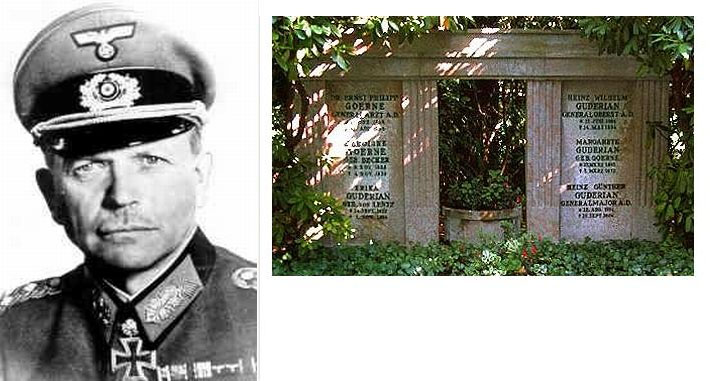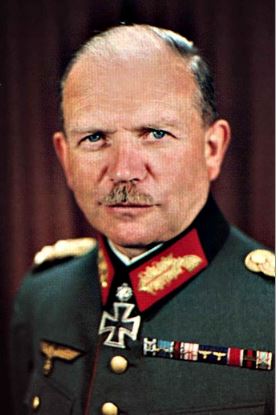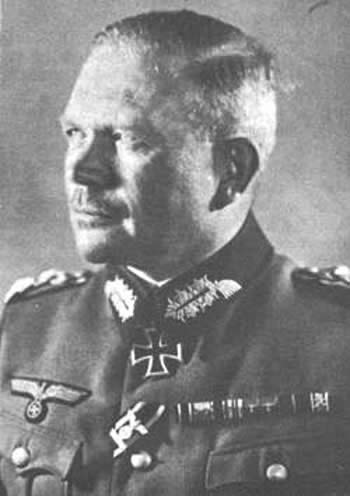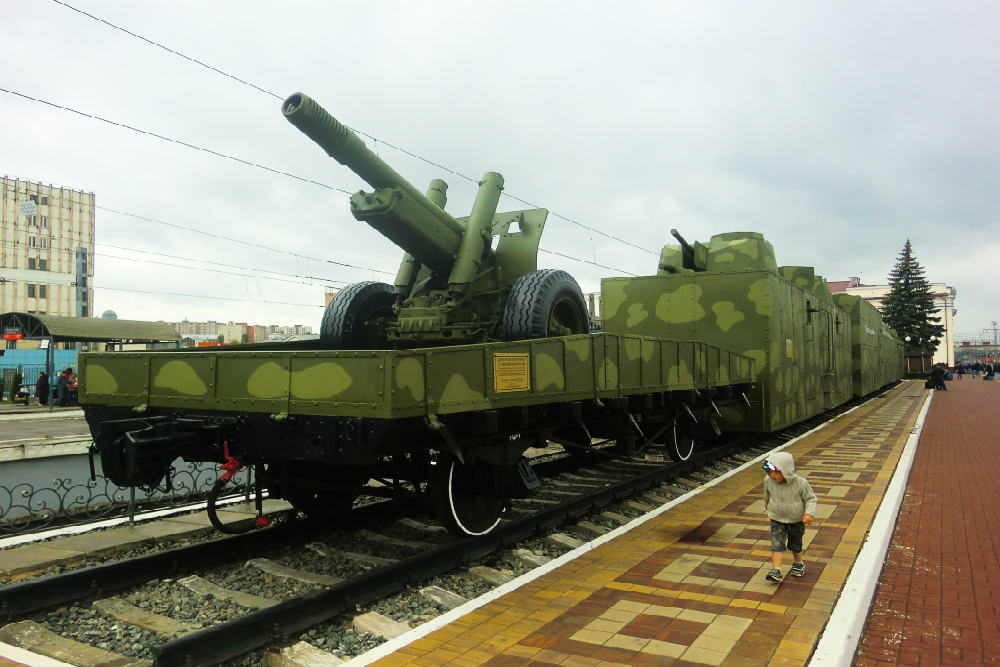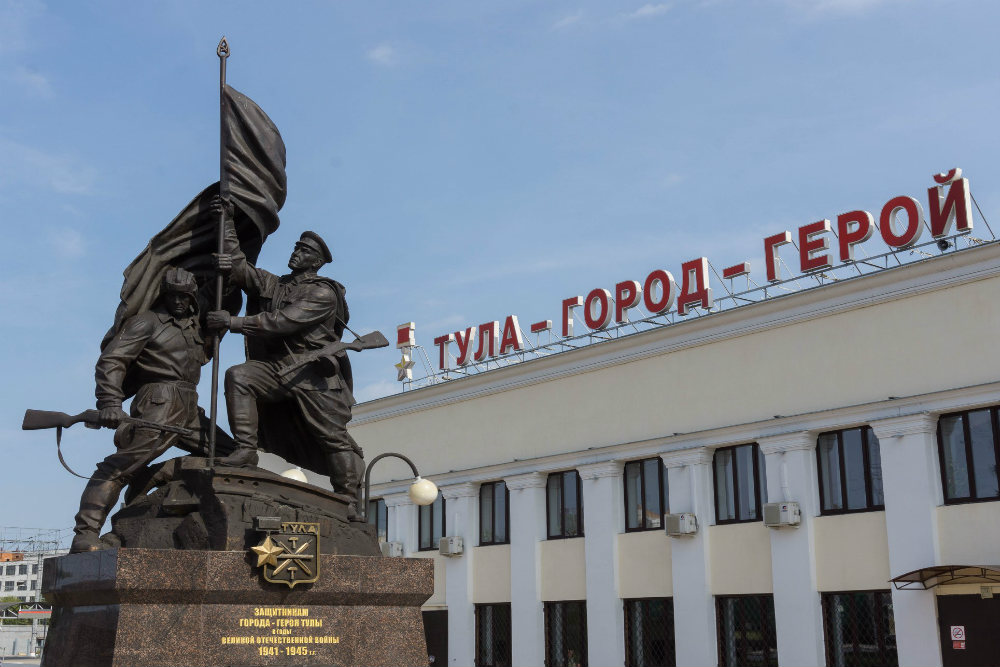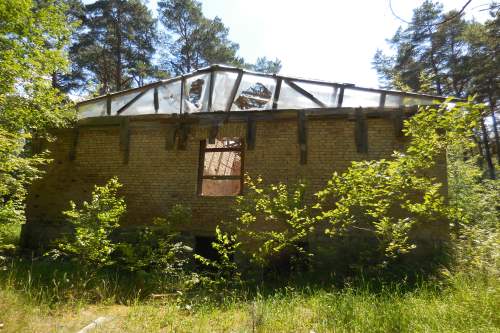Guderian, Heinz Wilhelm
- Date of birth:
- June 17th, 1888 (Kulm/West Prussia, Germany)
- Date of death:
- May 14th, 1954 (Schwangau/Allgäu, Germany)
- Nationality:
- German
Biography
Heinz Guderian was born June 17th, 1888 in the west Prussian town of Kulm, now the Polish town of Chelmno, as the son of a career soldier. He went to military school in 1901 and subsequently to the military academy in Berlin, graduating in 1907. He then took officers training, graduating in 1908 as Second Lieutenant. In 1913, he was married to Margarete Goerne, they had two sons who too were to serve in WW 2. Until the outbreak of WW 1, Guderian remained at the Military Academy where he was promoted to First Lieutenant in 1914 and later on to Captain. He served in various functions during the Great War and saw action in numerous theatres of operation. He served in the trenches at Verder and in the battle for the Marne. There he realized the futility of trench warfare.
After WW1, Guderian joined the Reichswehr. He occupied himself with the subject of mechanized warfare and was in actual command of a few motorized units. He traveled to Sweden and to the Soviet Union. During that period he was Inspector and commander of motorized transport units. After his rise to Colonel in 1933, he continued to publish articles on mechanized warfare. Hitler, deeply impressed by some of the armoured actions led by Guderian, ordered the establishment of three armoured divisions. Guderian was put in charge of one of these, the 2nd and was promoted to Major-general at the same time. A few months later he rose to Lieutenant-general and spearheaded the occupation of the Sudetenland with his 16th Army Corps. Following this 'Anschluss' he was promoted to General of armoured troops (General der Panzertruppen), responsible for recruiting and training. He finally had the freedom to convey his knowledge and experience to the members of armoured units.
Guderian's troops got their first taste of blood during the German invasion of Poland, September 1st, 1939. Guderian, being in charge of 19th Motorized Corps himself, managed to reach his objectives in this operation swiftly. For this he was awarded the Knight's Cross (Ritterkreuz) by Hitler. The attacks on France and the Low Countries in May 1940, in which he also took part, were even more successfull. He managed to advance at high speed through the difficult terrain in the Ardennes. In France, he moved swiftly up to the coast and later on, his troops managed to push through to the Swiss border, encircling the French troops west of the Maginot Line and securing the German victory over France. After this campaign, Guderian was promoted to one of the highest raks in the German army, that of Colonel-general, besides earning the nickname 'Schnelle Heinz' (Fast Heinz) for his swift advances.
At the start of Operation Barbarossa, Guderian was in command of 2 Panzergruppe. After the encirclement of Minsk, he came into conflict with Fieldmarshall Von Kluge who was opposed to Guderian's forces advancing too far and so exposing their flanks too much. Guderian was ordered to halt and wait for the infantry to catch up. Following the capture of Minsk, Guderian was awarded the Oak Leaves to his Knight's Cross (Eichenlaub zum Ritterkreuz). He found himself in a favorable position to advance on Moscow, which was virtually undefended at the time. Hitler however ordered him to move in support of the siege of Kiev, forcing him to make a detour of some 300 miles. The siege of Kiev proved to be succesfull but valuable time had been lost for the drive on Moscow. The drive was resumed in October of the same year and came within just a few kilometers of the city. The Russian winter and Soviet re-inforcements however halted the drive and even pushed it back. Hitler, always against any retreat, fired Guderian after he had executed a strategic withdrawal.
Hitler re-admitted Guderian into the Wehrmacht after Germany's defeat at Stalingrad. He was named Inspector of Armoured Forces and was tasked with modernizing them for the upcoming summer offensive, Operation Zitadelle. Together with the Secretary of Armaments, Albert Speer, he saw to it that production of tanks increased sharply but in spite of this, the summer offensive ended in disaster. Guderian however kept his post. After the failed assassination attempt on Hitler, July 20th, 1944, he became Chief of Staff of the landforces in the East. In this capacity he was responsible for halting the advancing Red Army. An unenviable and almost impossible task, Guderian to his disgust, had to watch Hitler taking away troops he so desperately needed himself. The troops were needed for a new operation in the west, Operation Sentry on the Rhine (Wacht am Rhein), better known as the battle of the Bulge. The operation failed and in the east, Soviet troops could now advance quickly against weak German resistance. After the failure of the Ardennes offensive, Hitler transfered a whole army from the west to Hungary for an attack on Budapest and the capture of the oilfields, Operation Frühlingserwachen (Waking of Spring). Guderian protested vehemently, arguing that these troops be deployed as a buffer between Berlin and the Red Army. A fierce dispute broke out, leading to Guderian's next dismissal on March 28th, 1945, after having pressed Hitler to negotiate an armistice with the Allies. May 1945, Guderian surrendered to US troops and was brought before the Neurenberg war tribunal. He was not sentenced. The Soviets however wished to charge him with war crimes but he was not extradited. After having been imprisoned between 1946 and 1948, he was released. Guderian died in Schwangau, Germany, May 14th, 1954. He will always be remembered as having perfected armoured warfare and the Blitzkrieg tactic, the principle of which is still in use by modern armies.
Promotions:
28.02.1907: Fähnrich
27.01.1908: Leutnant
08.11.1914: Oberleutnant
18.12.1915: Hauptmann
01.02.1927: Major
01.02.1931: Oberstleutnant
01.04.1933: Oberst
01.08.1936: Generalmajor
01.02.1938: Generalleutnant
01.11.1938: General der Panzertruppe
19.07.1940: Generaloberst (RDA (8) July 19th, 1940).
Career:
September 1st, 1939 - December 26th, 1941: Kommandierender General Panzerkorps / Oberbefehlshaber Panzerarmee;
December 27th, 1941 - February 27th, 1943: Ersatzheer;
February 28th, 1943: Generalinspekteur der Panzertruppen.
Do you have more information about this person? Inform us!
- Period:
- First World War (1914-1918)
- Awarded on:
- September 17th, 1914
- Period:
- First World War (1914-1918)
- Awarded on:
- December 15th, 1915
- Period:
- First World War (1914-1918)
- Awarded on:
- November 8th, 1916
- Period:
- First World War (1914-1918)
- Awarded on:
- 1934
- Period:
- First World War (1914-1918)
- Awarded on:
- January 14th, 1937
- Period:
- First World War (1914-1918)
- Awarded on:
- March 9th, 1937
- Period:
- Second World War (1939-1945)
- Rank:
- General der Panzertruppen (Lieutenant-General of Armoured Forces)
- Unit:
- Kdr, XIX. Armee-Korps
- Awarded on:
- September 5th, 1939
Had already received the Iron Cross 2nd Class on September 17th 1914.
- Period:
- Second World War (1939-1945)
- Rank:
- General der Panzertruppen (Lieutenant-General of Armoured Forces)
- Unit:
- Kdr, XIX. Armee-Korps
- Awarded on:
- September 13th, 1939
Had already received the Iron Cross 1st Class on November 8th 1916.
- Period:
- Second World War (1939-1945)
- Rank:
- General der Panzertruppen (Lieutenant-General of Armoured Forces)
- Unit:
- Kommandierender General, XIX. Armee-Korps
- Awarded on:
- October 27th, 1939
3rd Award.
Submitted on October 18th 1939.
- Period:
- Second World War (1939-1945)
- Rank:
- Generaloberst (General)
- Unit:
- Befehlshaber, Panzergruppe 2
- Awarded on:
- July 17th, 1941
24th Award
- Period:
- Second World War (1939-1945)
- Awarded on:
- August 6th, 1941
- Period:
- Second World War (1939-1945)
- Awarded on:
- August 7th, 1941
- Period:
- Second World War (1939-1945)
- Awarded on:
- September 21st, 1941
- Period:
- Second World War (1939-1945)
- Awarded on:
- October 18th, 1941
- Period:
- Second World War (1939-1945)
- Awarded on:
- October 19th, 1941
War Diary mentions
26 May 1945 WO 171/7822 - 110 Provost Company
On instructions received through APM from G(SD) Generals Koehler and Guederin and Colonel Mauff were arrested and sent to the internment camp at NEUMÜNSTER.
Sources
- Photo 1: Gareth Collins/Norbert Beyerlein
- Photo 2:
- Photo: Gareth Collins, Axisbiographical Research
- Pop-up grave: Norbert Beyerlein - - WEGMANN, GüNTER, Die Ritterkreuzträger der Deutschen Wehrmacht 1939-1945, Biblio-Verlag, 2009.
- Kwasny A., Kwasny G., Die Eichenlaubträger 1940-1945 (CD), Deutsches Wehrkundearchiv, Lage-Waddenhausen, 2001
- Fellgiebel W.P., Elite of the Third Reich, The recipients of the Knight's Cross of the Iron Cross 1939-1945: A Reference, Helion & Company Limited, Solihull, 2003, ISBN 1-874622-46-9
- Federl, C., Die Ritterkreuzträger der Deutschen Panzerdivisionen 1939-1945, VDM Heinz Nickel, Zweibrücken, Germany, 2000
- Go2War2.nl
- Axis Biographical Research
- Stellenbesetzung Generalinpekteur der Panzertruppen, 9 Oktober 1944




















